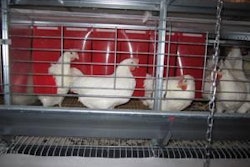Visions of the year 2020 from various sources suggest that the world production of poultry meat will approach 122.5 million metric tons and that 72 million metric tons of eggs will be produced globally by then. The potential market size by that time is indicated by a projected growth of the global human population from 6 billion in 1999 and approximately 7 billion in 2011, to a total of 7.5 billion people in 2020.
With the projected increases in per-person consumption of poultry meat and eggs over the next decades (chart 1), the global market’s composition is forecast to change so that chicken rivals pork as the world’s most popular meat (see charts 2 and 3).
Most of the extra demand for meat will be in the Asia-Pacific region (chart 4), with large increases for a number of Asian countries (chart 5).
Exports from Americas
In preparing the latest annual “Agricultural Outlook” publication on global prospects for the agriculture and food sectors, covering years 2011 to 2020, the Organisation for Economic Co-operation and Development, and the Food and Agriculture Organization of the United Nations worked on the basis of a series of assumptions. These included that world economies would continue recovering from crisis, population growth would continue to slow and energy prices would trend upwards.
The groups also recognised that many of the drivers of high and volatile commodity prices – weather, yields, cereals stocks and energy prices – may themselves be more volatile in the future. So while being cautiously optimistic that commodity prices would fall from the peaks of 2010 to 2011, the authors maintained the previously expressed view that agricultural commodity prices were likely to remain on a higher level during the next decade.
Slower rise for population
Nevertheless agricultural production and trade will continue to grow, the authors concluded, led by emerging economies where economic growth has resumed and appears to be resisting higher prices. All eyes at present are on the so-called BRIC countries of Brazil, Russia, India and China. After rising by almost 7.5% in 2011, the BRIC countries’ average annual economic growth, as measured by gross domestic product per person, has been projected to slow to 5.7% in 2015 and 4.75% in 2020, though still above the rates of other members of the developing countries group.
The annual growth rate of the world population, after averaging 1.2% in the past decade, is expected to drop to 1.05% between 2011 and 2020. The slowdown applies across all regions, said the OECD-FAO report, although more in developed rather than developing countries. Meanwhile the phenomenon of greater urbanisation will continue to reshape consumption patterns toward higher value processed products and convenience foods.
Firm demand, particularly from developing countries in Asia and Latin America, is forecast to boost the meat market in the decade ahead. FAO says world meat production will grow at an average rate of 1.8% per year until 2020, adding some 60 million metric tons in the process, and that 78% of the projected growth in meat supplies will involve production primarily of poultry and pig meat in the developing countries.
But the trade in poultry meat between countries will grow relatively slowly, at around 2% per year, rather than the 4.7% per year growth rate of exports seen in the past decade. The expectation is that the USA and Brazil will strengthen their dominance of world trade over the period so that, by 2020, the two countries account for nearly half of the additional export supply in world markets.
According to a European Commission report on prospects for agricultural markets, EU-27 poultry meat production could grow to 12.47 million metric tons in 2020, from under 12 million tons in 2011 and around 12.2 million tons in 2015. The uptake of poultry meat by European Union consumers seems set to grow from the current 23.4 kilograms per person per year, to 27.7 kg in 2020, with the EU zone as a net importer by 2016.
Europe’s prospects for exporting poultry meat during this period are likely to be constrained both by its relatively high production costs and by an assumed strengthening of the Euro currency, so that total exports fall back to below 740,000 metric tons from a 2011 level of about 966,000 tons. By contrast, American analysts have projected that a relative weakness of the U.S. dollar in currency exchange rates will make U.S. exports more competitive.
Within the USA, analysts forecast increased retail prices for meat over the next two years or so, but with added costs of production keeping producer margins tight. They also see the next few years as the time of opportunity for chicken to win U.S. market share against pork and beef by being more available and lower priced. Potentially, domestic chicken production could grow by more than 1.6% over the next decade.
On current assessments, the global demand for eggs could reach 71 million metric tons per year by 2015. The largest increases in egg production between 2011 and 2015 are likely to occur in Brazil, Turkey, India and China. But a longer-term view also points to China and India having the greatest demand for more eggs because of more mouths to feed. By 2050, these two countries are expected to hold a combined one-third of the global human population.
Egg forecasts of the percentage growth in production weight, comparing 2015 with 2011, range between only 0.6% in the European Union and 0.3% in Japan, to 9% to 10% in China and Indonesia, 14% in India and Turkey, and 17% in Brazil.
Already representing the fastest regional growth rate in egg production since 2000, Asia has also been identified as the driver of further increases in the global average number of eggs consumed per person annually. The current average is about 175 eggs per person, but may exceed 200 within the next 8 to 9 years.
Currently, less than 2% of eggs are traded internationally compared to 60% of beef. However, demand from developing countries is expected to drive the total egg market to a 20% expansion over the next 10 years, bringing with it an increase in the trading of egg products.

















